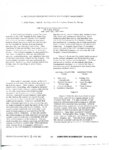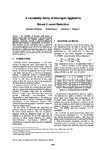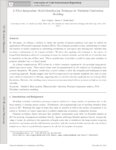Filters: Collection:"ir_uspace" Year End:2012
| Creator | Title | Description | Subject | Date | ||
|---|---|---|---|---|---|---|
| 101 |  | Warner, Homer R. | A Distributed Processing System for Patient Management | Biomedical Informatics | 1978 | |
| 102 |  | Mecklenburg, Robert | A dossier driven persistent objects facility | We describe the design and implementation of a persistent object storage facility based on a dossier driven approach. Objects are characterized by dossiers which describe both their language defined and "extra-linguistic" properties. These dossiers are generated by a C+-f- preprocessor in concert ... | Persistent object storage facility; Dossier driven | 1994 |
| 103 |  | Zhang, Lixin | A DRAM backend for the impulse memory system | The Impulse Adaptable Memory System exposes DRAM access patterns not seen in conventional memory systems. For instance, it can generate 32 DRAM accesses each of which requests a four-byte word in 32 cycles. Conventional DRAM backends are optimized for accesses that request full cache lines. They m... | Impulse Adaptable Memory System; DRAM | 1998-12-16 |
| 104 |  | Sobh, Tarek M. | A dynamic framework for intelligent inspection | CAD (Computer Aided Design) typically involves the design, manufacture and inspection of a mechanical part. The problem of reverse engineering is to take an existing mechanical part as the point of departure and to inspect or produce a design, and perhaps a manufacturing process, for the part. We pr... | CAD; Discrete event dynamic systems; DEDS | 1992 |
| 105 |  | Sobh, Tarek M.; Henderson, Thomas C. | A dynamic framwork for intelligent inspection | CAD Computer Aided Design typically involves the design manufacture and inspection of a me chanical part. The problem of reverse engineering is to take an existing mechanical part as the point of departure and to inspect or produce a design and perhaps a manufacturing process for the part. ... | CAD; Manufacture; Inspection; Intelligent inspection | 1992 |
| 106 |  | Sobh, Tarek M.; Henderson, Thomas C. | A dynamic recursive structure for intelligent exploration | We suggest a new approach for inspection and reverse engineering applications. In particular, we investigate the use of discrete event dynamic systems (DEDS) to guide and control the active exploration and sensing of mechanical parts for industrial inspection and reverse engineering. We introduce dy... | Intelligent exploration; Discrete event dynamic systems; DEDS; Dynamic recursive finite state machines; DRFSM | 1992 |
| 107 |  | Sobh, Tarek M.; Henderson, Thomas C. | A dynamic recursive structure for intelligent inspection | We suggest a new approach for inspection and reverse engineering applications. In particular we investigate the use of discrete event dynamic systems DEDS to guide and control the active exploration and sensing of mechanical parts for industrial inspection and reverse engineering?? We introduce... | Intelligent inspection; Discrete event dynamic systems; DEDS; Industrial inspection; Dynamic recursive structure | 1992 |
| 108 |  | Fogel, Alan Dale | A dynamic systems approach to infant facial action | What does it mean when a baby smiles? Is it an expression of enjoyment, a signal to a partner that rewards effective caretaking, or simply a muscular contraction? Do physically different types of smiles indicate different things? Should the social context in which an infant smiles inform our unders... | 1997 | |
| 109 |  | Whitaker, Ross T. | A fast iterative method for a class of Hamilton-Jacobi equations on parallel systems | In this paper we propose a novel computational technique, which we call the Fast Iterative Method (FIM), to solve a class of Hamilton- Jacobi (H-J) equations on massively parallel systems. The proposed method manages the list of active nodes and iteratively updates the solutions on those nodes u... | Fast Iterative Method; FIM; Parallel systems | 2007 |
| 110 |  | Whitaker, Ross T. | A fast iterative method for solving the eikonal equation on triangulated surfaces | 2012 | ||
| 111 |  | Smith, Kent F. | A fast parallel squarer based on divide-and-conquer | Fast and small squarers are needed in many applications such as image compression. A new family of high performance parallel squarers based on the divide-and-conquer method is reported. Our main result was realizing the basis cases of the divide-and-conquer recursion by using optimized n-bit primiti... | Squarer; Parallel squarers; Divide-and-conquer; MOPS; CMOS | 1995 |
| 112 |  | Mathews, V. John | A fast recursive least-squares adaptive nonlinear filter | This paper presents a fast, recursive least-squares (RLS) adaptive nonlinear filter. The nonlinearity in the system is modeled using the Hammerstein model, which consists of a memoryless polynomial nonlinearity followed by a finite impulse response linear system. The complexity of our method is abou... | 1988 | |
| 113 |  | Mathews, V. John | A fast recursive least-squares second order volterra filter | ABSTRACT This paper presents a fast, recursive least-squares (RLS) adaptive nonlinear filter. The nonlinearity is modelled using a second order Volterra series expansion. The structure presented in the paper makes use of the ideas of fast RLS multichannel filters and has a computational complexity ... | 1988 | |
| 114 |  | Henderson, Thomas C.; Hansen, Charles D. | A fault tolerant sensor scheme | Multi-sensor systems pose the problem of how to coherently and efficiently treat the data provided by the various sensors. However. the availability of greater numbers of sensors also broadens the ability to build fault tolerant sensor systems. We define a framework in which sensors can be abstractl... | Multi-sensor systems; Logical sensors | 1983 |
| 115 |  | Simpson, Jamesina J. | A feasibility study of microjets applied to breast cancer detection | The feasibility of detecting small tumors of diameter 0.5mm inside a human breast is demonstrated using microjets. Microjets are photonic nanojets scaled to microwave frequencies wherein a plane-wave-illuminated dielectric sphere produces a high-intensity, narrow beam of light extending from the sha... | 2012-01-01 | |
| 116 |  | Mallat, Chibli | A Federal Israel-Palestine: Ending 100 Years of Civil War in the Holy Land? | What if we substitute a federal Israel-Palestine for the two-state solution deadlock? | 2010-09-17 | |
| 117 |  | Mallat, Chibli | A Federal Israel-Palestine: Nonviolence and Law to End the 100-year Civil War | In the first part of this study, the deadlock in Israel-Palestine was presented as a 100-year civil war. New realities on the ground, as well as visionary calls for a united state, instead of partitioning the land at a heavy human cost, have come from leading US thinkers, notably Tony Judt and Seyla... | 2010-09-23 | |
| 118 |  | Sutherland, James Clayton | A filter-independent model identification technique for turbulent combustion modeling | In this paper, we address a method to reduce the number of species equations that must be solved via application of Principal Component Analysis (PCA). This technique provides a robust methodology to reduce the number of species equations by identifying correlations in state-space and defining new v... | 2012-01-01 | |
| 119 |  | Gerig, Guido | A framework for longitudinal data analysis via shape regression | Traditional longitudinal analysis begins by extracting desired clinical measurements, such as volume or head circumference, from discrete imaging data. Typically, the continuous evolution of a scalar measurement is estimated by choosing a 1D regression model, such as kernel regression or fitting a p... | estimating | 2012-01-01 |
| 120 |  | Lindstrom, Gary E. | A framework for module-based language processors | A system composed of interconnected modules is a module-based system. We present an object-oriented (0-0) framework for the development of processors for module-based systems, such as compilers for 0-0 languages, linkers/loaders, and tools for user/system libraries. We claim t h a t this framework,... | Language processors; Jigsaw; Module-based | 1993 |
| 121 |  | Michell, Nick | A gallium arsenide mutual exclusion element | A mutual exclusion element is a key component in building asynchronous and self-timed circuits. As part of our effort to design high performance self-timed circuits, we have designed a mutual exclusion element in gallium arsenide. This circuit has been fabricated in a 1.2? process and tested. A test... | Mutual exclusion element; Self-timed circuits | 1993 |
| 122 |  | Mathew, Binu K.; Davis, Al; Fang, Zhen | A Gaussian probability accelerator for SPHINX 3 | Accurate real-time speech recognition is not currently possible in the mobile embedded space where the need for natural voice interfaces is clearly important. The continuous nature of speech recognition coupled with an inherently large working set creates significant cache interference with other... | Speech recognition; SPHINX 3; Speech recognizers | 2003-07-22 |
| 123 |  | Gopalakrishnan, Ganesh | A general compositional approach to verifying hierarchical cache coherence protocols | Modern chip multiprocessor (CMP) cache coherence protocols are extremely complex and error prone to design. Modern symbolic methods are unable to provide much leverage for this class of examples. In [1], we presented a method to verify hierarchical and inclusive versions of these protocols using ... | Hierarchical cache coherence protocols; Verification | 2006-11-26 |
| 124 |  | Sobh, Tarek M. | A general review, graphical environment, and applications for discrete event and hybrid systems in Robotics and Automation | 1994 | ||
| 125 |  | Yang, Yue; Gopalakrishnan, Ganesh; Lindstrom, Gary E. | A generic operational memory model specification framework for multithreaded program verification | Given the complicated nature of modern architectural and language level memory model designs, it is vital to have a systematic ap- proach for specifying memory consistency requirements that can support verification and promote understanding. In this paper, we develop a spec- ification methodolog... | Multithreaded program verification | 2003 |
